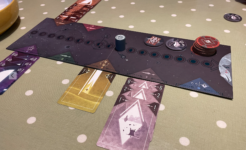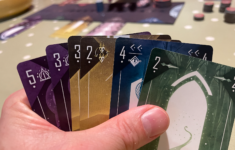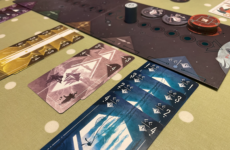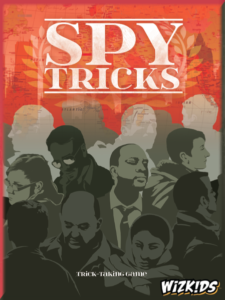- Learning time
- 20 minutes
- First play time
- 80 minutes
Shamans
Designed by: Cédrick Chaboussit
Shamans is a trick-taking game with a hidden traitor. But although players work together to try and prevent that traitor from winning a round, the game is won and lost individually.
The board is placed centrally with the shadow piece on it, and character cards are dealt out that players look at secretly: most will be Shaman, but one or two (depending on the number of players) will be the treacherous Shadows. Then the world cards are dealt out so each player has a hand of cards before play begins in standard trick-taking fashion: the starting player lays a card, and everyone else does likewise going clockwise around the table.
In trick-taking games the norm is that when a suit is led (eg green) players must follow suit if possible. However in Shamans, this rule can be ignored. The Shamans will want to follow if they can, because every card of a different suit played moves the shadow piece along the track towards the moon. And the shadows will want to not-follow as much as they can for the same reason: if the shadow piece reaches the moon, the shadows win the round and score points.
The Shamans win the round simply by preventing that happening, but it’s not straightforward, because as cards run out it gets harder and harder to follow suit and the shadow piece begins galloping at a rate of knots towards the moon!
Fortunately – or occasionally not – there are other elements at play you can manipulate to your own ends. The highest card of the led suit in a trick determines the starting player (again, pretty standard for trick-taking games) but the lowest on-suit card allows whomever played it to take a token from the board. These do a few different things: some award points, some force you to reveal your character (not a token the shadows will want!), some let you move the shadow piece forward or back along the track – and some allow you to eliminate another player from the round! If the last shadow is eliminated, the Shamans instantly win. However, the eliminations can only happen if you played the last card of a suit, as this trigger’s each suits power: most of them allow an elimination, but one forces the instigator to swap roles.
Rounds continue in this way until at least one player has reached the number of points required to win.
The guru's verdict
-
Take That!
Take That!
Certainly present - players may be accusing, and possibly eliminating, each other.
-
Fidget Factor!
Fidget Factor!
Fairly low, although the game's ambience is one of puzzled suspicion and deduction...
-
Brain Burn!
Brain Burn!
Mostly by the time the end of the round arrives, everyone knows who the shadows are. But stopping them is a different matter...
-
Again Again!
Again Again!
A very clever, thinky game with enough moving parts to keep it fresh















Sam says
One of two trick-taking 'traitor' games with hidden roles I've played. I enjoy both but probably prefer Inside Job for being both more accessible and funnier. But that's not to damn Shamans with faint praise - I've thoroughly enjoyed playing it, even if it's a slightly denser undertaking with more moving parts. If the sound of it appeals I suspect it won't disappoint - and it looks rather beautiful too.